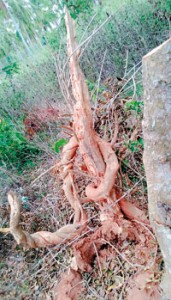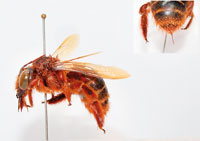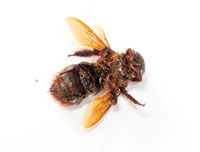News
Tragedy in 2014 leads to discovery of killer sting
A research team’s work following the death of a labourer two years ago in Puttalam has led to the documentation of the first-ever reported case of fatal stinging by the Large Carpenter Bee, earlier considered to be harmless

Dead tree-trunk with nest entrance holes from where the killer bee, Xylocopa tranquebarica, emerged.
It is a first, a tragic first though, in Sri Lanka.
When a humble manual labourer set out from his home in a remote area of Puttalam in September 2014, he was intent on making a few hundred rupees to feed his family. What he did not know was that he would fall victim, the first in the country, to a Large Carpenter Bee (Xylocopa tranquebarica) considered a rare species here, and return home only in a coffin.
The 59-year-old and a fellow labourer had left home around 7.30 in the morning to fix a fence bordering a coconut estate and a forested area in remote Adapana Willuwa, south of Puttalam, a Dry Zone section of the North Western Province. It was a 2km walk to the site, from the closest motorable road and by 8.30 a.m. he was clearing some bushes next to a dead tree-trunk.
Disturbed by the hacking of the bushes, several insects had flown out of the dead tree-trunk and as he shouted for help, swarmed around his head, with one stinging him on the right side of his face just below the right eye.
The deadly sequence of events had occurred quickly thereafter – with the bee still being attached to the labourer’s face, his companion had slapped it dead, while the victim complained of severe pain in the face. Having rested for about 10 minutes, he had, however, resumed work, felt faint, complained of difficulty in breathing, sat awhile and collapsed. His wife had then been informed and after her arrival, the labourer had been carried to the road and taken to the Puttalam Hospital around 10 a.m. He had been pronounced dead on arrival.
A small item in a newspaper on this sudden death after a bee-sting had caught the eye of Prof. S.A.M. Kularatne of the Faculty of Medicine, University of Peradeniya, far away from Puttalam. He had then picked up the paper trail and followed through with a quick phone call to the Puttalam Hospital, while also getting other researchers on board.
The research team’s meticulous work has led to the documentation of the first-ever reported case of fatal stinging by the Large Carpenter Bee, earlier considered to be harmless. This is what the team has put under the spotlight in the reputed international journal, ‘Wilderness Environmental Medicine’ in May, this year.
The focus on this ‘killer bee’ has been by Prof. Kularatne; Prof. Jayanthi Edirisinghe & Dr. Inoka Karunaratne of the Department of Zoology, Faculty of Science, University of Peradeniya; Dr. Sathasivam Raveendran of the Puttalam Base Hospital; and Dr. Kosala Weerakoon of the Department of Parasitology, Faculty of Medicine and Allied Sciences, University of Rajarata.
Explaining that in the order Hymenoptera, bees (mee-messo and bambaru) and hornets and wasps (both called debaru) are well-known stinging insects whose envenoming can be fatal, the team states that though their stinging attacks are common in rural and forested areas of the country, ‘fatal stinging’ by the large-bodied Carpenter Bees has been unreported before.
“The autopsy on the labourer who was declared dead on admission to the hospital 90 minutes after the stinging, found normal coronary arteries and heart, but the lungs were slightly congested and contained secretions in the bronchi,” the team states, disclosing that acute anaphylaxis was the most likely cause of death.
Thereafter, the team presents the habitat, morphology, attack pattern and medical importance of Large Carpenter Bees.
· In the class Insecta, members of the order Hymenoptera are best known for their role in pollination, biological control of insect-pests and as stinging insects. The bees, hornets and wasps in this order are distinct and unique in having a modified ovipositor as a stinger that acts in association with a venom gland. Stinging attacks by bees and wasps on humans have become a common occurrence in Sri Lanka.
· Bees of the world are classified into seven families, of which four families — Colletidae, Halictidae, Megachilidae and Apidae – are found in Sri Lanka. There are 148 species of bees in 38 genera under these four families in the country.
· Apidae is represented by several sub-families, genera and sub-genera in Sri Lanka, one of which is the sub-family Xylocopinae, an assemblage of very diverse pollen bees. In this sub-family is the tribe Xylocopini, represented by the single genus Xylocopa. Under the Xylocopini and genus Xylocopa are usually large to very large robust bees easily confused with temperate bumble bees.
· Several sub-genera of the genus Xylocopa occur the world over, while the subgenus Nyctomelitta represented by two species is confined to the Eastern hemisphere. Of the two species, X. tranquebarica, is known to have a paleotropical distribution and occurs from Sri Lanka to India, Sumatra and Borneo and from Java to Thailand and Laos. This species is nocturnal.
Pointing out that the spouse of the patient had denied any history of allergies or past Hymenoptera stings in connection with her husband, the team states that the Judicial Medical Officer (JMO) who performed the postmortem examination had noted the stinging site, a punctum with fresh bleeding on the right malar area, that the heart and all coronary arteries were normal, the upper airway was normal, but the lungs were slightly congested and had secretions in the bronchial tree and the rest of the organs were normal.
With the dead insect being brought to the entomologist at the Peradeniya University’s Department of Zoology for identification, it had been curated, identified, catalogued and deposited in the reference collection. At the request of the entomologist, the JMO had visited the coconut estate, the site of the stinging a few days after the incident, and located the dead tree trunk. When workers cut open part of the trunk, five more live insects had been found inside the burrows.
“The insects were not aggressive and were collected into a container and brought to the Department of Zoology for identification. The dead ‘attacker’ and those brought later were identified as X. tranquebarica and were sexed and measured,” says Prof. Kularatne, adding that the body length of the bees ranged from 25 to 27mm. The attacker’s condition was poor. It was a female with the stinging apparatus partly broken, most likely during removal from the skin of the victim.
The study states: “We report a sudden fatal case after a sting by an insect previously not identified as being of medical significance. Such incidents, although common among the Apis bees (especially Apis dorsata, the giant Asian honey bee or bambara), have not been reported previously for Carpenter Bees of the genus Xylocopa.
“While the autopsy finding of normal coronary arteries and heart excludes an acute coronary event, evidence of congestion of the lungs and secretions in the bronchi support the possibility of an acute anaphylactic reaction as the immediate cause of death. As this was the first known case of fatal envenoming by this species of insect, the venom profile has yet to be determined. The stings of Apis bees and hornets in Sri Lanka are known to cause anaphylaxis, acute coronary events and even profound pulmonary congestion, leading to death, but there have been no reports of instantaneous deaths.
“The pattern of allergy and anaphylaxis in humans has wide variations and it is quite possible that the victim in this report might have had severe hypersensitivity to some components of the venom of X. tranquebarica. Stinging insects of the Hymenoptera order are well reputed for allergy and anaphylaxis.”
 Female Xylocopa tranquebarica collected from the nest site in Puttalam. Inset. Tip of the abdomen showing the stinger (length of the body, 25mm) Unique status of Carpenter Bee calls for public awareness Underscoring the importance of raising public awareness about the potential dangers posed by them and the need to avoid encounters with them, Prof. Kularatne urges that as rural workers are at particular risk, they should be advised to take precautions when they notice Carpenter Bees. These bees could be inhabiting deadwood or nests in grasses, particularly in the early hours of the morning. Recommending further research into the venom chemistry of these bees to better understand their toxic effects, the team urges that they should be regarded as potentially hazardous stinging insects which attack under extreme provocation. | |
The profile of the bee  The offending Xylocopa tranquebarica. Note the partly broken stinging apparatus at the posterior end of the abdomen (length of the body, 27mm) Nyctomelitta bees are large and thickly covered with golden reddish-brown pubescence. Both sexes have large eyes that converge above and ocelli that are larger than the antennal sockets. X. tranquebarica has been found to be night-foragers in other countries. In the study in Sri Lanka, their natural habitat and nesting site were a forested area devoid of human dwellings. “It is likely that the insects nesting in the dead tree-trunk were disturbed by the nearby clearing of the bushes and became aggressive. But by noon, they seemed very reclusive inside the burrows of the tree trunk,” the study adds. While the Smithsonian Sri Lanka Insect Survey 1976 and past literature pinpoint to 13 species of Carpenter Bees being found in Sri Lanka, X. tranquebarica is considered a rare species. The first reported case of this species of bee in Sri Lanka is believed to be from the Northern Province in 1905; then in 1976 (through the Smithsonian Sri Lanka Insect Survey) from Ampara in the Eastern Province; and the more recent record from Giritale in the North Central Province. X. tranquebarica is also the only nocturnal Xylocopa species thus far known to be from Sri Lanka.
|

